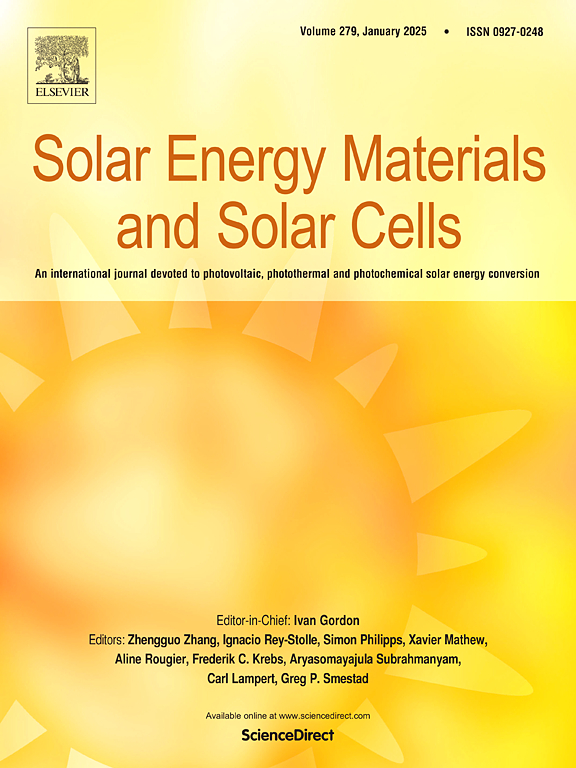IF 6.3
2区 材料科学
Q2 ENERGY & FUELS
引用次数: 0
摘要
建筑供暖能耗的快速增长要求开发先进的热管理技术。将相变材料(PCMs)集成到建筑系统中是降低能耗的有效策略。然而,实现受控过冷、相分离抑制和高效能量收集仍然具有挑战性。本研究开发了由十二水磷酸氢二钠(Na2HPO4-12H2O,DHPD)和五水硫代硫酸钠(Na2S2O3-5H2O,STP)组成的共晶水合盐(EHSs)作为 PCMs,并使用偏硅酸钠水合物(Na2SiO3-9H2O,SMN)作为成核剂来降低过冷度。改性三聚氰胺海绵(MMS)用于吸附 EHS,防止相分离,而耐腐蚀的高强度聚氨酯光固化树脂则将 EHS 包裹起来,形成基于 DHPD-STP 的复合 PCM(CPCM),命名为 EHS/MMS@PU。所得 EHS PCM 的相变温度为 26.1 °C,焓值为 134.54 J/g,过冷度为 2.3 °C。MMS 有效抑制了相分离,聚氨酯涂层提高了防漏性、结构完整性和循环稳定性。在温度调节性能实验中,相变培养箱表现出了显著的效率,其保持温度舒适的时间大约是空白对照培养箱的三倍。这些复合材料表现出了卓越的热管理能力,凸显了其作为建筑应用中有效热围护结构的潜力。本文章由计算机程序翻译,如有差异,请以英文原文为准。
Advanced engineering of binary eutectic hydrate composite phase change materials with enhanced thermophysical performance for high-efficiency building thermal energy storage
The rapid increase in energy consumption for building heating necessitates the development of advanced thermal management technologies. The integration of phase change materials (PCMs) into building systems offers an effective strategy to mitigate energy consumption. However, achieving controlled supercooling, phase separation suppression, and efficient energy harvesting remains challenging. In this study, eutectic hydrated salts (EHSs) composed of disodium hydrogen phosphate dodecahydrate (Na2HPO4·12H2O, DHPD) and sodium thiosulfate pentahydrate (Na2S2O3·5H2O, STP) were developed as PCMs, with sodium metasilicate hydrate (Na2SiO3·9H2O, SMN) used as a nucleating agent to reduce supercooling. The modified melamine sponge (MMS) was employed to adsorb the EHS, preventing phase separation, while a corrosion-resistant, high-strength PU light-curing resin encapsulated the EHSs to form DHPD-STP-based composite PCMs (CPCMs), designated as EHSs/MMS@PU. The resulting EHSs PCMs exhibited a phase transition temperature of 26.1 °C, an enthalpy of 134.54 J/g, and a supercooling degree of 2.3 °C. MMS effectively inhibited phase separation, and the PU coating improved leakage prevention, structural integrity, and cycling stability. In the thermoregulation performance experiments, the phase-change incubator exhibited remarkable efficiency by maintaining a thermally comfortable temperature for approximately three times longer than the blank control incubator. These composites demonstrated superior thermal management capabilities, highlighting their potential as effective thermal envelopes for building applications.
求助全文
通过发布文献求助,成功后即可免费获取论文全文。
去求助
来源期刊

Solar Energy Materials and Solar Cells
工程技术-材料科学:综合
CiteScore
12.60
自引率
11.60%
发文量
513
审稿时长
47 days
期刊介绍:
Solar Energy Materials & Solar Cells is intended as a vehicle for the dissemination of research results on materials science and technology related to photovoltaic, photothermal and photoelectrochemical solar energy conversion. Materials science is taken in the broadest possible sense and encompasses physics, chemistry, optics, materials fabrication and analysis for all types of materials.
 求助内容:
求助内容: 应助结果提醒方式:
应助结果提醒方式:


